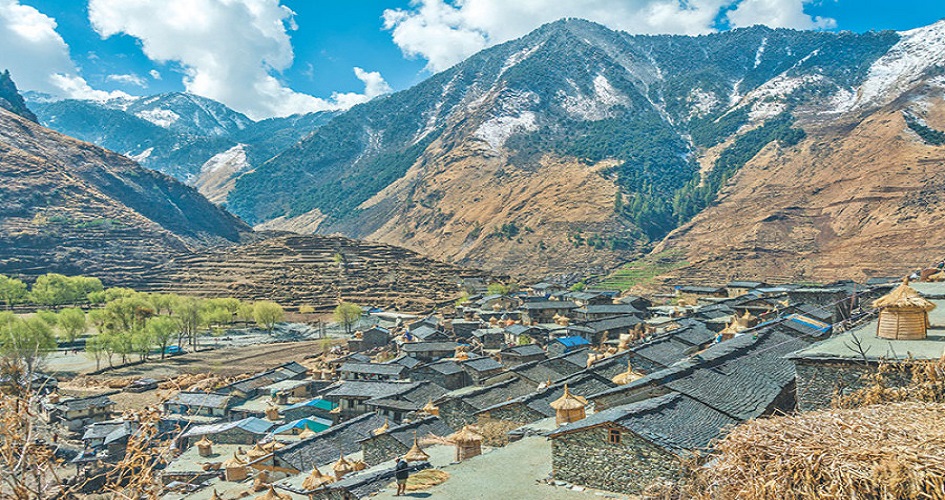The Rukum District lies in the northernmost portion of the Rapti Zone, in the Bheri River basin. Rukum district is 2,877 square kilometres in size, with Musikot as its administrative centre.
The majority of this district is drained by west-flowing tributaries such as the Uttar Ganga, which drains the Dhorpatan Valley to the north, and the Sani Bheri, which drains the western Dhaulagiri Himalayas to the south.
Introduction to Rukum District
The temperature of Rukum varies from sub-tropical to continuous snow and ice, with elevations ranging from 800 meters along the Bheri to 6000 meters in Dhaulagiri.
Yarsagumba (Ophiocordyceps sinesis), historical monuments, caravan paths, and abundant wildlife may be found in the Rukum area. The Rukum area is also known as the district with 52 lakes and 53 hills.
How Can You Reach Rukum District?
The district of Rukum may be reached in one of two ways. They are:
- By Land
- By Air
By Land
Rukum is easily accessible by road, with many local buses and leased vehicles available to get you there. From Gongabu Bus Park, you may get a local bus that will take you to Chanute. To go to Rangsi and the top portion of Rukum, you must change vehicles.
It takes around 8 hours and 328 kilometres to go to Chanauta from Gongabu Bus Park. A one-way bus ticket to Chanauta costs between Rs. 800 and 1000 per person.
By Air
There are two ways to get to Rukum from the airport. The first option is to fly from Kathmandu to Nepaljung and then drive from there to Rukum. Flying from Kathmandu to Rukum takes around 50 minutes and costs between $80 and $160.
There is no set pricing because it varies with the seasons and events. To go to Rukum, you may locate or hire local cars in Nepalgunj. Depending on your previous destination, it takes 4 to 6 hours.
The second option is to fly from Kathmandu to Surkhet and then drive to Rukum. The flight from Kathmandu takes approximately an hour and costs between $100 and $300. You may take a local bus or hire a car from Surkhet and travel to Rukum. According to your last point, it takes 3 to 5 hours.
When Is The Best Time To Visit Rukum District?
Rukum is a valley surrounded by magnificent hills and abundant wildlife. The hills and high altitude fields encompass much of the Rukum valley. As a result, please avoid the monsoon and winter seasons, as these are not conducive to your health. The ideal months to visit the Rukum district are October to November and June to August.
Places To Visit In Rukum
While in the Rukum area, there are numerous things worth seeing. They are:
- Rukmini Lake
- Shibalaya
- Syarpu Lake
- Deurali Cave
- Guerilla Trek
Rukmini Lake
Rukmini Lake, also known as Kamal Daha, is a famous lake across the Rukum District. Breathtakingly beautiful green hills surround this lake. This lake will be much more lovely in the spring when the lotus blooms bloom. The beauty of this lake attracts many domestic tourists.
Shibalaya
Lord Shiva is worshipped in Shibalaya Temple, as well as the famous Hindu Temple of Rukum. This temple, which was built under the Rana Regime, is the oldest in the area. This is only an ancient monument built by Ranas in the mid-western area.
On the northern side of Rukmini Lake, there is a Hindu temple. The lingam of Shiva is the primary shrine of this temple. During Shivaratri, Chaturdashi, and Teej, many devotees flock here to worship Lord Shiva.
Syarpu Lake
Syarpu Lake is another lovely tourist attraction in Rukum, and it is located in Baphikot VDC. Rukum's Musikot Airport is 35 kilometers away from Syarpu Lake. 
This 2.6-square-kilometre lake is triangular. A wide range of aquatic animals may be found in this lake.
Deurali Cave
The Deurali cave, located in the eastern section of Rukumkot, is another well-known tourist attraction. This cave is situated on the Rumgad River's bank. There is now no motorable road; therefore, we must trek from the town. We pass by several beautiful ponds and lush woodlands on our stroll, which distracts us from our weariness.
Guerilla Trek
In the Nepalese mid-hills, visit lonely woods and a nomadic hamlet. This journey allows you to experience an ear attack and escape, as well as see historic Maoist Guerrilla combat sites. This route is also flanked by thick woodland and lovely rhododendron groves.
Guerrilla trekking also allows you to immerse yourself in the local culture fully. You will get the opportunity to learn about Jersey culture. You will get the chance to see the cultural dancers perform Danphe and Peacock dances.















